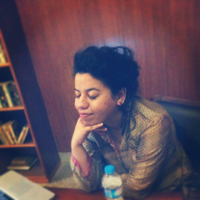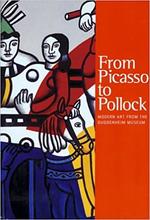More about Georges Braque
- All
- Info
- Shop
Works by Georges Braque

Contributor
Georges Braque wasn’t a womanizer or deadbeat; he was never in jail or partook in drugs; he was just an artist standing in front of an audience, asking them to love his paintings.
Born on May 13, 1882 in Argenteuil-sur-Seine, France, Braque was always going to do something artsy. His father and grandfather were house painters, and little Georges was going to be no different, until he started taking classes at L’École des Beaux-Arts in Le Havre. And then he moved to Paris, where he apprenticed with a master decorator to receive his craftsman certificate in 1901. After that he studied at the Académie Humbert with people like Marie Laurencin and Francis Picabia. It was a stacked class. Braque started out as an Impressionist but upon seeing the Fauvists, with their crazy colors, switched his style immediately, which might have been the wildest thing he had ever done up until that moment.
Braque was getting some attention for his art and had a solo show in 1908. Everything was running smoothly until he visited Picasso’s studio and saw Les Demoiselles d’Avignon. The two developed a sweltering bromance and according to Braque "would get together every single day to discuss and assay the ideas that were forming, as well as to compare [their] respective works." They were dubbed by Wayne White, “the original Cubist cowboys,” but Picasso referred to Braque as “ma femme,” or “my wife.” This might have been appropriate because the two did parent the Cubist movement together but this definitely has some misogynistic undertones that Picasso was not not known for. The two were inseparable until Braque enlisted in the French Army during World War I.
During the war, Braque got really messed up in the head. Literally, not metaphorically. He sustained a head injury so bad that it caused temporary blindness and it took him two years to fully recover. But recover he did. He continued his art career in peace making badass things like the stage for Russian ballets, and stained glass windows for the church of Varengeville. He stayed in Paris during World War II, making still life paintings, and was lucky miss that whole degenerative art accusation. He soon was too old for the large commissions of yore and died on August 31, 1963.
In 2010, there was a theft at the Musée d'Art Moderne de la Ville de Paris that included the painting by Braque, L'Olivier Près de l'Estaque, along with works by Picasso, Matisse, Modigliani, and Fernand Léger. The estimated value was over $120 million and they have yet to be returned. As heists go, this is a pretty impressive one as the burglar “slip[ped] past three night watchmen on duty, disassembl[ed] a window, [chose] five specific works and then slip[ped] out unnoticed by the guards.” Impressive, but tragic.
Sources
- "Georges Braque." Guggenheim.org. N.p., 2018. Web. 21 Aug. 2018.
- "Georges Braque's Life And Legacy." The Art Story. N.p., 2018. Web. 20 Aug. 2018.
- Kachur, Lewis. "Braque, Georges | Grove Art." Oxfordartonline.com. Web. 20 Aug. 2018.
- "Matisse, Picasso And Other Masterpieces Stolen From Paris Museum - France 24." France 24. N.p., 2010. Web. 21 Aug. 2018.
- Meier, Allison. "The Cubist Cowboy Rodeo." Hyperallergic. N.p., 2013. Web. 20 Aug. 2018.
- Smith, Roberta. "The Other Father Of Cubism." Nytimes.com. N.p., 2011. Web. 20 Aug. 2018.

Contributor
We don’t know him as well as we know Picasso, but Georges Braque is right up there with Pablo when it comes to that little art movement known as “Cubism."
Braque started out in the Impressionist style, his earlier work quite similar to Cezanne’s. From there on, he poked his fingers in a couple of other stylistic pies, and eventually winded up gorging on something called Analytic Cubism.
Lots of people think that Picasso was the daddy of Cubism, and it’s probably because Picasso was a kind of celebrity artist in his time, with a personality that intrigued those around him. But his buddy, Braque, who was also his colleague, had a quieter personality and stayed confined to his studio rather than parade around at parties. Braque and Picasso worked so closely together that at times you can barely tell their work apart – like the twins from the Parent Trap! Braque, together with his sexier twin, Picasso, experimented with lots of new techniques that seem like pretty standard stuff today, like collage, but was new for the times.
Up until WW1, Braque and Picasso kept hatching Cubist eggs together, until Braque was enlisted in the French Army. Just a year after, Braque was injured and was rendered temporarily blind. It took him about a year to recover and came back to Cubism in full swing, though this time he flew solo. His work is as important as that of his Cubist contemporaries, and this we know because his painting was kidnapped in 2010 from the Musée d'Art Moderne de la Ville de Paris, alongside the likes of Picasso and Matisse. And hey, nothing validates artistic genius like having your work stolen!
Featured Content
Here is what Wikipedia says about Georges Braque
Georges Braque (/brɑːk, bræk/ BRA(H)K;
French: [ʒɔʁʒ bʁak]; 13 May 1882 – 31 August 1963) was a major 20th-century French painter, collagist, draughtsman, printmaker and sculptor. His most notable contributions were in his alliance with Fauvism from 1905, and the role he played in the development of Cubism. Braque's work between 1908 and 1912 is closely associated with that of his colleague Pablo Picasso. Their respective Cubist works were indistinguishable for many years, yet the quiet nature of Braque was partially eclipsed by the fame and notoriety of Picasso.
Check out the full Wikipedia article about Georges Braque



















